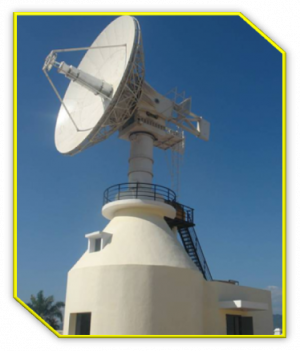If you wish to contribute or participate in the discussions about articles you are invited to contact the Editor
BeiDou Ground Segment: Difference between revisions
No edit summary |
No edit summary |
||
| Line 8: | Line 8: | ||
}} | }} | ||
The Compass Navigation Satellite System (CNSS), also named BeiDou-2, is China’s second-generation satellite navigation system that will be capable of providing positioning, navigation, and timing services to users on a continuous worldwide basis. | The [[Work in Progress:COMPASS General Introduction|Compass Navigation Satellite System (CNSS)]], also named BeiDou-2,<ref name=Chinese_today>[http://www.sinodefence.com/space/satellite/compass-beidou2.asp Compass Satellite Navigation System (Beidou), on Sinodefence.com, updated on August 6th, 2011.] </ref> is China’s second-generation satellite navigation system that will be capable of providing positioning, navigation, and timing services to users on a continuous worldwide basis.<ref name=Chinese_today/><ref name=COMPASS_Wiki>[http://en.wikipedia.org/wiki/Compass_navigation_system COMPASS Navigation system in Wikipedia]</ref> | ||
Although the upgrade of its regional navigation system towards a global solution started in 1997, the formal approval by the Government of the development and deployment of BeiDou-2/CNSS was done in 2004.<ref name=Chinese_today/> The system is currently under development evolving from a regional system called [[Work in Progress:Other Regional Systems|BeiDou-1]], and in the first phase will provide high-accuracy positioning services for users in China and its neighbouring regions by 2012.<ref name=Chinese_today/> In a second stage, the system will evolve to provide global navigation services by 2020, similarly to the [[GPS General Introduction|GPS]], [[GLONASS General Introduction|GLONASS]] or [[GALILEO General Introduction|Galileo]] systems.<ref name=Chinese_today/> | |||
As of August 2011, nine satellites for Compass have been launched, the first eight of which completed the deployment foreseen for the first phase of BeiDou-2.<ref name=Chinese_today/><ref name=BEIDOU_MUNICH_2011>China Satellite Navigation Office, ''Development of BeiDou Navigation Satellite System'', Munich Satellite Navigation Summit, 2011.</ref><ref name="Compass-IGSO3">[http://business.globaltimes.cn/industries/2011-04/642763.html ''China completes basic Beidou (Compass) Navigation Satellite System''], 2011-04-10 by Globaltimes.cn</ref> | |||
==COMPASS Ground Segment== | ==COMPASS Ground Segment== | ||
The COMPASS Ground Segment consists of:<ref name= | The COMPASS Ground Segment consists of:<ref name=BEIDOU_MUNICH_2011/> | ||
* a Master Control Station: responsible for satellite constellation control and processing the measurements received by the Monitor Stations to generate the navigation message. | * a Master Control Station: responsible for satellite constellation control and processing the measurements received by the Monitor Stations to generate the navigation message. | ||
* | * Upload Stations: responsible for uploading the orbital corrections and the navigation message to Compass satellites. | ||
* | * Monitor Stations, which collect Compass data for all the satellites in view from their locations. | ||
In June 2011, the system has completed the ground segment equipment development, installation and commissioning, with all functions operating normally. <ref>[http://www.cnkeyword.info/compass-system-10-months-to-complete-a-comprehensive-test-covering-the-asia-pacific-region-next-year/ ''Compass system 10 months to complete a comprehensive test covering the Asia Pacific region next year''] China news, 20th June 2011.</ref> | In June 2011, the system has completed the ground segment equipment development, installation and commissioning, with all functions operating normally. <ref>[http://www.cnkeyword.info/compass-system-10-months-to-complete-a-comprehensive-test-covering-the-asia-pacific-region-next-year/ ''Compass system 10 months to complete a comprehensive test covering the Asia Pacific region next year''] China news, 20th June 2011.</ref> | ||
Revision as of 07:03, 2 September 2011
| COMPASS | |
|---|---|
| Title | BeiDou Ground Segment |
| Author(s) | GMV. |
| Level | Basic |
| Year of Publication | 2011 |
The Compass Navigation Satellite System (CNSS), also named BeiDou-2,[1] is China’s second-generation satellite navigation system that will be capable of providing positioning, navigation, and timing services to users on a continuous worldwide basis.[1][2]
Although the upgrade of its regional navigation system towards a global solution started in 1997, the formal approval by the Government of the development and deployment of BeiDou-2/CNSS was done in 2004.[1] The system is currently under development evolving from a regional system called BeiDou-1, and in the first phase will provide high-accuracy positioning services for users in China and its neighbouring regions by 2012.[1] In a second stage, the system will evolve to provide global navigation services by 2020, similarly to the GPS, GLONASS or Galileo systems.[1]
As of August 2011, nine satellites for Compass have been launched, the first eight of which completed the deployment foreseen for the first phase of BeiDou-2.[1][3][4]
COMPASS Ground Segment
The COMPASS Ground Segment consists of:[3]
- a Master Control Station: responsible for satellite constellation control and processing the measurements received by the Monitor Stations to generate the navigation message.
- Upload Stations: responsible for uploading the orbital corrections and the navigation message to Compass satellites.
- Monitor Stations, which collect Compass data for all the satellites in view from their locations.
In June 2011, the system has completed the ground segment equipment development, installation and commissioning, with all functions operating normally. [5]
Notes
References
- ^ a b c d e f Compass Satellite Navigation System (Beidou), on Sinodefence.com, updated on August 6th, 2011.
- ^ COMPASS Navigation system in Wikipedia
- ^ a b China Satellite Navigation Office, Development of BeiDou Navigation Satellite System, Munich Satellite Navigation Summit, 2011.
- ^ China completes basic Beidou (Compass) Navigation Satellite System, 2011-04-10 by Globaltimes.cn
- ^ Compass system 10 months to complete a comprehensive test covering the Asia Pacific region next year China news, 20th June 2011.

